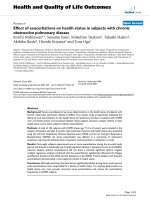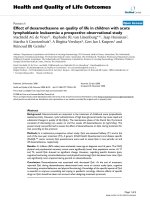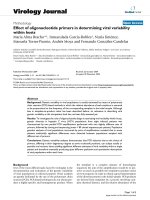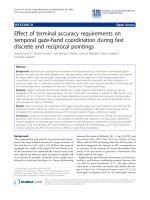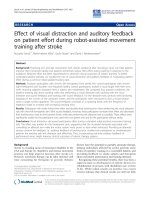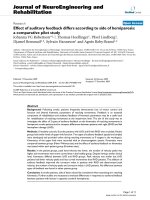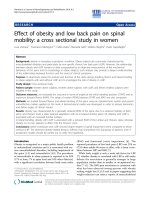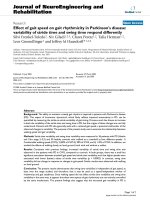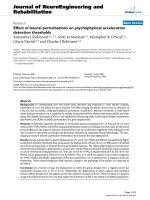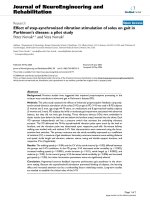báo cáo hóa học:" Effect of multiple micronutrient supplementation on survival of HIV-infected children in Uganda: a randomized, controlled trial" ppt
Bạn đang xem bản rút gọn của tài liệu. Xem và tải ngay bản đầy đủ của tài liệu tại đây (672.1 KB, 9 trang )
Ndeezi et al. Journal of the International AIDS Society 2010, 13:18
/>Open Access
RESEARCH
© 2010 Ndeezi et al; licensee BioMed Central Ltd. This is an Open Access article distributed under the terms of the Creative Commons
Attribution License ( which permits unrestricted use, distribution, and reproduction in
any medium, provided the original work is properly cited.
Research
Effect of multiple micronutrient supplementation
on survival of HIV-infected children in Uganda: a
randomized, controlled trial
Grace Ndeezi*
1,2
, Thorkild Tylleskär
2
, Christopher M Ndugwa
1
and James K Tumwine
1
Abstract
Background: Micronutrient deficiencies compromise the survival of HIV-infected children in low-income countries.
We assessed the effect of multiple micronutrient supplementation on the mortality of HIV-infected children in Uganda.
Methods: In a randomized, controlled trial, 847 children aged one to five years and attending HIV clinics in Uganda
were stratified by antiretroviral therapy (ART, n = 85 versus no ART, n = 762). The children were randomized to six
months of either: twice the recommended dietary allowance of 14 micronutrients as the intervention arm (vitamins A,
B
1
, B
2
, niacin, B
6
, B
12
, C, D and E, folate, zinc, copper, iodine and selenium); or the standard recommended dietary
allowance of six multivitamins (vitamins A, D
2,
B
1
, B
2
, C and niacin) as a comparative "standard-of-care" arm. Mortality
was analyzed at 12 months of follow up using Kaplan Meier curves and the log rank test.
Results: Mortality at 12 months was 25 out of 426 (5.9%) children in the intervention arm and 28 out of 421 (6.7%) in
the comparative arms: risk ratio 0.9 (95% CI 0.5 - 1.5). Two out of 85 (2.4%) children in the ART stratum died compared
with 51 out of 762 (6.7%) in the non-ART stratum. Of those who died in the non-ART stratum, 25 of 383 (6.5%) were in
the intervention arm and 26 of 379 (6.9%) in the comparative arm; risk ratio 1.0 (95% CI 0.6 - 1.6). There was no
significant difference in survival at 12 months (p = 0.64, log rank test). In addition, there was no significant difference in
mean weight-for-height at 12 months; 0.70 ± 1.43 (95% CI 0.52 - 0.88) for the intervention versus 0.59 ± 1.15 (95% CI
0.45 - 0.75) in the comparative arm. The mean CD4 cell count; 1024 ± 592 (95% CI 942 - 1107) versus 1060 ± 553 (95%
CI 985 - 1136) was also similar between the two groups.
Conclusions: Twice the recommended dietary allowance of 14 micronutrients compared with a standard
recommended dietary allowance of six multivitamins for six months was well tolerated, but it did not significantly alter
mortality, growth or CD4 counts. Future intervention studies should carefully consider: (1) the composition and dosing
of the supplements; and (2) the power needed to detect a difference between arms.
Trial Registration: ClinicalTrials.gov Identifier: NCT00122941
Background
Mortality in HIV-infected children living in low-income
countries is still high compared with high-income coun-
tries [1,2]. Malnutrition in children under five years of
age is highly prevalent and both macro and micronutrient
deficiencies are likely to co-exist [3-6], especially among
HIV-infected children.
Micronutrients are important for maintaining optimal
functioning of the individual's immune response. Sele-
nium and vitamin E are involved in the maintenance of
the oxidant defence system, while zinc and vitamin A play
a significant role in maintaining cellular integrity [7].
Vitamin B
12
is important in the formation of proteins and
proper functioning of a large number of enzymes and the
immune system [8]. Deficiency of the important compo-
nents of the endogenous anti-oxidant defence system
leads to accumulation of oxidative stress, including oxida-
tive damage [9]. Vitamin A and zinc deficiencies are asso-
* Correspondence:
1
Department of Paediatrics and Child Health, School of Medicine, College of
Health Sciences, Makerere University, Kampala, Uganda
Full list of author information is available at the end of the article
Ndeezi et al. Journal of the International AIDS Society 2010, 13:18
/>Page 2 of 9
ciated with increased susceptibility to infections,
increased severity of illness and mortality [10,11].
Studies in HIV-infected children have demonstrated
that multiple, large doses of vitamin A reduces diarrhoea
episodes, increases CD4 count and reduces all-cause
mortality [12-14]. Zinc supplementation in children
whose HIV status was not known in Asia and Latin
America reduced the incidence, duration and severity of
diarrhoea and pneumonia episodes [15]. In a study of effi-
cacy and safety of zinc, mortality was lower in the zinc-
supplemented group [16]. Most of these studies were sin-
gle micronutrient interventions, yet deficiencies are less
likely to exist singly: hence the efforts to provide multiple
micronutrients as opposed to single nutrient supple-
ments in both children and adults studies [17-21].
To achieve normal plasma levels of micronutrients,
HIV-infected adults required multiples of the recom-
mended dietary allowance (RDA) compared with HIV-
negative men. Those consuming adequate recommended
intake had a relatively high prevalence of deficiencies
compared with uninfected adults with similar intake [22].
Multivitamin supplementation using multiples of the
RDA resulted in reduction of progression to Stage 4 dis-
ease and mortality in pregnant and lactating women in
Tanzania [13].
Supplementation with multiple micronutrients had no
effect on mortality in one study of adults with HIV [23],
while it reduced mortality in another trial that used mul-
tiples of RDAs in patients with CD4 counts of less than
200/mm
3
[18]. Hitherto, there are no published studies
that have examined the effect of multiple micronutrient
supplementation on mortality of HIV-infected children.
The objective of this study was to assess the efficacy of
a supplement containing twice the RDA (2 RDA) of 14
multiple micronutrients on mortality of HIV-infected
children in Uganda, and to document any adverse effects
associated with this dosing of multiple micronutrients.
We hypothesized that daily administration of twice the
recommended dietary allowance of multiple micronutri-
ents to HIV-infected children aged one to five years for
six months would reduce all-cause mortality from 24% to
14.4% in one year.
Methods
Study design, site and population
This was a randomized, controlled, double-blind, hospi-
tal-based trial of a supplement containing twice the RDA
(2 RDA) of 14 micronutrients (minerals and vitamins)
versus a formula of six multivitamins at the standard
RDA (1 RDA) dose administered to HIV-infected chil-
dren for a period of six months and followed up to 12
months. The trial was conducted between June 2005 and
June 2008 in Uganda at: the Paediatric HIV clinics of the
national referral hospital (Mulago); two private, not-for-
profit centres (Nsambya Hospital and Mildmay Centre)
in Kampala, the capital city; and four regional hospitals
(Mbale, Mbarara, Masaka, Lira).
At each site, a paediatrician was in charge of the study
and worked with a nurse and laboratory technician, who
had undergone training on study procedures. The princi-
pal investigator initiated the study at all the sites and
supervised data collection once a week at the Kampala
(central) sites and once every four weeks at the regional
hospitals (rural sites). Similar operating procedures were
followed.
The principal investigator or another paediatrician
enrolled children aged one to five years whose mothers or
caretakers gave informed written consent to participate
and who had attended the clinic at least once. The moth-
ers or caretakers also had to adhere to a regular study fol-
low-up schedule for one year. Their HIV status had
earlier been confirmed by either an antibody test or
DNA-PCR if younger than 18 months of age. These chil-
dren were stratified into two groups: those receiving anti-
retroviral drugs (ARVs) and those not yet started on
antiretroviral therapy (ART). Children enrolled in other
studies, those residing more than 15 kilometres from the
clinic and those whose parents or caretakers were antici-
pating moving from the study area were excluded.
The study was approved by Makerere University Col-
lege of Health Sciences Research and Ethics Committee,
the participating hospitals, the Uganda National Council
for Science and Technology and the Regional Committee
for Medical Research Ethics, Western Norway. Counsel-
ling for initiation of ART and adherence was offered to all
the participants, while ongoing adherence counselling
was provided to those who were already receiving ART.
Initiation of ART, treatment for concurrent illnesses and
prophylaxis was offered according to the World Health
Organization (WHO) and national paediatric HIV man-
agement guidelines.
Micronutrient supplements
The trial supplements were manufactured in the form of
a white powder, packaged in plastic containers and seri-
ally labelled according to strata (S1 or S2). The interven-
tion supplement consisted of twice the recommended
dietary allowance (2 RDA) of vitamins A, B
1
, B
2
, niacin,
B
6
, B
12
, C, D and E, folate, zinc, copper, iodine and sele-
nium; the comparative "standard-of-care" supplement
consisted of the RDA (1 RDA) of vitamins A, C, D, B
1
, B
2
and niacin (Table 1).
The comparative "standard-of-care" supplement was
designed to be similar to the regular multivitamin tablet
supplied as the standard of care at paediatric HIV clinics
in Uganda. Upon administration to the child, both sup-
plements were dissolved in milk or water. The nurse dem-
onstrated how to prepare a dose and allowed the mother
Ndeezi et al. Journal of the International AIDS Society 2010, 13:18
/>Page 3 of 9
to prepare and administer the first dose in the clinic. Each
participant received 140g (one container) per month,
which was equivalent to 35 doses.
Randomization and blinding
The eligible participants were randomized to either the
intervention or "standard-of-care" in two strata. A WHO
officer in Geneva, who was not part of the study team,
generated the randomization code in permuted blocks of
4 to 20 using the Stata software. The list was sent to
NUTRISET (France), which manufactured the trial sup-
plements and packaged them in serially labeled identical
containers. The consistency of the powder, colour and
smell were similar. All investigators, staff and parents or
caretakers were blinded to treatment assignment. The
randomization code was made available to the investiga-
tors upon completion of data collection.
Clinical and laboratory assessment
Mothers or caretakers were interviewed about the chil-
dren's previous medical, nutritional history and present-
ing symptoms. The participants underwent a detailed
physical examination, including anthropometry and
WHO staging for paediatric HIV/AIDS. Weight was
taken using a scale (uniscale 01-410-15) to the nearest
0.1kg, and height was taken to the nearest 0.1 centimetre
using a portable infant-child length-height measuring
board (Shorr productions, Olney, Maryland, USA). A
plastic tape was used to measure mid-arm circumference
to the neatest 0.1cm. HIV/AIDS clinical disease staging
was decided using clinical signs against the WHO classi-
fication for paediatric HIV [24].
Two millilitres (ml) of blood was collected in a 5ml
EDTA vacutainer tube (Becton Dickinson, Franklin
Lakes, N.J.) by venipuncture from the cubital fossa or
dorsum of the hand, and was analyzed for a complete
blood count (Act 5Diff instrument Beckman Coulter )
and CD4 cell count (FACScan instrument and MultiSET
software Beckton Dickinson). C-reactive protein (CRP)
was analyzed using a qualitative method (Human Gesell-
schaft fur Biochemica und Diagnostica mbH, Germany).
Agglutination indicated a C-reactive protein of more than
6mg/L and this was reported as a positive CRP. An addi-
tional 3-5ml blood sample was collected and serum was
analyzed for zinc and other trace elements using induc-
tively coupled atomic emission spectrometry (ICP-AES)
[25].
Participants were followed at the clinics monthly for
the first six months, and at nine and 12 months. A record
of illness, anthropometry, physical examination findings,
investigations and treatment was kept for each visit. Par-
ents or caretakers were requested to report to the clinic
whenever the child got sick, was admitted to hospital or
died. Those admitted were followed until discharge, and
if they died, information was recorded on a mortality and
adverse event form. Information on missed doses of the
supplement was recorded on each monthly visit for six
months.
Compliance was assessed by measuring the remaining
supplement using a light-weight weighing scale (Philips
HR 2389/B 9.OV/DC). Each study participant was
expected to take 4g of the supplement per day (one
scoop) and this was equivalent to 120g in 30 days. A pro-
Table 1: The formulation of intervention supplement and the comparative "standard-of-care" supplement used in the
supplementation trial of HIV-infected children, Uganda
Micronutrient Intervention arm 2 RDA Comparative arm "standard-of-care" 1 RDA
Vitamin A (mcg) 800 400
VitaminB1 (mg) 1.2 0.6
Vitamin B2 (mg) 1.2 0.6
Niacin (mg) 1.6 0.8
Vitamin B6 (mg) 1.2 -
Vitamin B12 (mcg) 2.4 -
Vitamin C (mg) 50 25
Vitamin D (IU) 400 200
Vitamin E (mg) 14 -
Folate (mcg) 400 -
Selenium (mcg) 60 -
Zinc (mg) 10 -
Copper (mcg) 800 -
Iodine (mcg) 180 -
Ndeezi et al. Journal of the International AIDS Society 2010, 13:18
/>Page 4 of 9
portion of the amount of supplement taken against the
expected was used as a measure of compliance. Overall
compliance was assessed at the end of six months,
whereby the average compliance was derived by adding
the compliance rates on all the six scheduled visits.
After six months, no study supplements were given, but
the children received the regular multivitamin supple-
ments from the clinic as the standard of care. Follow up
to 12 months was to ascertain whether there was any sus-
tained effect of the intervention. Children who were not
brought for scheduled visits were traced by telephone or
physically by the health visitor. Those who missed more
than two scheduled visits and could not be traced were
declared lost.
Outcomes
Information on mortality was collected from verbal
reports by the parents or caretakers or from hospital
records. Those who died at home were reported by tele-
phone or through tracing. Side effects attributed to the
supplement were assessed and recorded at the monthly
visits. A serious adverse event (SAE) form was completed
if an adverse event had occurred. Conditions that
resulted in hospitalization, required medical intervention
to prevent a serious outcome, or were life threatening or
fatal were regarded and reported as SAEs. The paediatri-
cian decided on the relationship to the intervention using
a set of conditions or known side effects of micronutri-
ents. All SAEs warranted stoppage of the trial supplement
when closely related to the intervention.
Statistical issues
The estimated sample size of 411 children in each arm
was based on data from two studies. The first assumption
was a mortality rate in the comparative arm of 24% in one
year, based on the mortality rate in a study conducted in
Mulago Hospital, Kampala, before highly active antiretro-
viral therapy (HAART) was available to HIV-infected
children [26]. The mortality among HIV-infected chil-
dren occurring between the ages of 12 and 25 months
was close to 24%. We assumed a similar mortality in the
whole age span of one to five years.
The second assumption - that all-cause mortality would
be reduced to 14.4% (a 40% reduction) - was based on a
study in Tanzanian children aged six months to five years
where supplementation with vitamin A was associated
with a 49% reduction in overall mortality and 63% among
HIV-infected children [13]. We decided to use the 40%
reduction level as we anticipated improved general care
of HIV-infected children over time. Finally, we used a
precision of 5%, and 95% confidence interval. The power
estimate was 90% with an assumption of 10% loss to fol-
low up.
Weight-for-height (WHZ), height-for-age (HAZ) and
weight-for-age (WAZ) z-scores were computed using the
WHO International Growth References [27]. Sub-group
analysis was based on whether the children were receiv-
ing ART or not.
Statistical analysis was performed using SPSS version
15.0. Baseline characteristics were compared in the two
treatment groups using proportions, and differences were
tested with the Chi-square or Fisher's Exact test. To
determine the association between patients' characteris-
tics and mortality, logistic regression was used. Risk
ratios and 95% confidence intervals were used to test the
strength of association. Comparisons of treatment effi-
cacy were analyzed on intention-to-treat basis in the two
arms. Kaplan Meier curves and the log rank test were
used to compare survival in the two arms.
Results
A total of 1632 children aged 12 to 59 months attending
paediatric HIV clinics at the study sites were screened for
eligibility (Figure 1). Out of the 847 children enrolled, 704
(83.1%) were from the study sites in Kampala (the capital
city); the rest were from the rural sites.
Baseline characteristics of participants
Almost equal proportions of children were assigned to
the two arms in both strata. More than half of the chil-
dren (470/847, 56%) were aged less than 36 months. Table
2 shows the baseline characteristics and these were com-
parable in the two groups.
Follow up
All the study participants took 85% or more of the study
supplements. Adverse effects were reported in 16 chil-
dren (1.9%) and these included vomiting in 12 children
and diarrhoea in four children. Of the 12 children who
vomited, 6/426 (1.4%) were in the intervention arm and
6/421(1.4%) in the comparative arm. These symptoms
were minor and did not warrant stopping the supple-
ment. There were no other adverse effects attributed to
the intervention.
By 12 months, 124 (14.6%) children were lost to follow
up: 67/426 (15.7%) in the intervention arm and 57/
421(13.5%) in the comparative arm. Most of the partici-
pants lost to follow up (90/124; 72.5%) were from the cen-
tral region (Kampala sites). However, the proportion of
loss to follow up was higher in the regional than the cen-
tral sites (23.8% vs. 12.8%; p < 0.01). Children who were
not receiving cotrimoxazole routinely (22.7% vs. 13.7%; p
= 0.04), CRP positive (13.5% vs. 9.0%; p = 0.00) and those
who were underweight (19.9% vs. 12.1%; p = 0.01) were
also more likely to be lost to follow up. The other charac-
teristics were similar to those who completed the study.
Ndeezi et al. Journal of the International AIDS Society 2010, 13:18
/>Page 5 of 9
Mortality
The overall mortality at 12 months of follow up was 53/
847 (6.3%). In the intervention arm, the mortality was 25/
426 (5.9%) and in the comparative arm 28/421 (6.7%).
The difference between the arms was not statistically sig-
nificant; risk ratio 0.9 (95% CI 0.5 - 1.5). In the ART stra-
tum, two out of the 85 (2.4%) children died compared
with 51/762 (6.7%) in the non-ART stratum. Of those
who died in the non-ART stratum, 25/383 (6.5%) were in
Figure 1 Trial profile.
Stratified:
847
ART stratum
Randomized: 85
Lost to follow up: 1
Withdrew: 0
Transferred: 1
Total excluded: 785
- Other studies: 218
- Inconsistent carers: 172
- Distance >15km: 348
- Declined to consent: 47
Screened for eligibility:
1632
Survived:
41
Died:
0
Survived:
38
Died:
2
Intervention arm:
43
Comparative arm:
42
Non-ART stratum
Randomized: 762
Lost to follow up: 66
Withdrew: 5
Transferred: 8
Survived:
279
Died:
25
Survived:
284
Died:
26
Intervention arm:
383
Comparative arm:
379
Lost to follow up: 0
Withdrew: 0
Transferred: 2
Lost to follow up: 57
Withdrew: 6
Transferred: 6
Table 2: Baseline characteristics of the 847 Ugandan HIV-infected children aged 1-5 years enrolled in the micronutrient
supplementation trial by ART stratum
Characteristics ART stratum (n = 85) Non-ART stratum (n = 762)
Intervention arm
n = 43 (%)
Comparative arm
n = 42 (%)
p-value Intervention arm
n = 383 (%)
Comparative arm
n = 379 (%)
p-value
Age <36 months 8 (8.6) 16 (38.1) 0.06 219 (57.2) 227 (59.9) 0.46
Male 20 (46.5) 23 (54.8) 0.52 201 (52.5) 182 (48.0) 0.25
Caretaker: mother 24 (55.8) 21 (50.0) 0.67 278 (72.6) 278 (73.4) 0.87
Study site: Kampala 40 (93.0) 40 (95.2) 1.00 313 (81.7) 311 (82.1) 0.93
Fever 9 (20.9) 8 (19.0) 1.00 76 (19.8) 81 (21.4) 0.65
Diarrhoea 1 (2.3) 2 (4.8) 0.62 42 (11.0) 51 (13.5) 0.32
Cough 27 (62.8) 26 (61.9) 1.00 220 (57.4) 219 (57.8) 0.94
Persistent diarrhoea 0 (0.0) 0 (0.0) - 11 (26.8) 11 (23.4) 0.81
Cotrimoxazole prophylaxis 43 (100.0) 42 (100.0) - 340 (88.8) 334 (88.1) 0.82
Routine multivitamins 18 (41.9) 13 (31.0) 0.37 241 (62.9) 219 (57.8) 0.16
Vitamin A in past 6 months 20 (46.5) 16 (38.1) 0.51 183 (47.8) 175 (46.2) 0.66
WHO Stage 3 or 4 - - - 124 (33.4) 114 (30.1) 0.53
WHZ less than -2 z score 2 (4.6) 3 (7.1) 1.00 53 (13.8) 50 (13.2) 0.75
HAZ less than -2 z score 22 (51.2) 23 (54.7) 1.00 190 (49.6) 197 (51.9) 0.65
WAZ less than -2 z score 5 (11.6) 6 (14.3) 1.00 110 (8.7) 125 (32.9) 0.24
Current hospitalization 1 (0.02) 3 (7.1) 0.36 27 (7.0) 16 (4.2) 0.12
Ever hospitalized 25 (58.1) 27 (64.3) 0.66 226 (59.0) 200 (52.8) 0.09
CRP positive (n = 565) 15 (24.6) 11 (18.0) 0.65 122 (24.1) 119 (23.5) 0.70
CD4% <20 (n = 720) 10 (27.0) 8 (24.2) 1.00 124 (38.4) 136 (41.6) 0.42
Zinc <10 μmol/L (n = 336) 5 (26.3) 14 (73.7) 0.01 86 (50.6) 84 (49.4) 0.62
Ndeezi et al. Journal of the International AIDS Society 2010, 13:18
/>Page 6 of 9
the intervention arm and 26/379 (6.9%) in the compara-
tive arm; risk ratio 1.0 (95% CI 0.6 - 1.6).
Figure 2 shows the Kaplan Meier probability of survival
by arm. There was no significant difference in survival at
12 months of follow up (log rank statistic 0.22, 1df, p-
value 0.64). The mean survival time was 10.6 months
(95% CI 10.3 - 10.9) in the intervention arm and 10.7 (95%
CI 10.4 - 11.0) in the comparative arm. The mean survival
time was 11.6 months in the ART (95% CI 11.3 - 12.0)
stratum and 10.5 (95% CI 10.3 - 10.8) in the non-ART
stratum.
On bivariate analysis for baseline characteristics, pres-
ence of fever, diarrhoea, cough, hospitalization at enrol-
ment, low anthropometric indices below minus 2 z-
scores, and WHO Stage 3 or 4 disease were associated
with a shorter time of survival (Table 3). Those who were
taking cotrimoxazole routinely within one month before
the study had better survival. Other baseline characteris-
tics and routine multivitamin supplementation were not
significantly associated with mortality. At multivariate
analysis, presence of fever, hospitalization at enrolment
visit, WHO Stage 3 or 4, and being underweight indepen-
dently predicted early mortality.
The most common cause of death was pneumonia
accounting for 20/53 (37.7% )of the deaths: eight of the 20
children died of severe pneumonia, six of severe acute
malnutrition with severe pneumonia, three of pnemocys-
tis jiroveci pneumonia and a further three died of measles
with severe pneumonia. Acute febrile illness and malaria
accounted for 11/53 (20.8%) of the deaths, including eigth
deaths due to acute febrile illness/malaria, two to cerebral
malaria and one child died of malaria with severe anae-
mia.
Other causes of death were acute diarrhoea with dehy-
dration (6/53; 11.3%), persistent diarrhoea with dehydra-
tion (3/53; 5.7%), measles with other complications (3/53;
5.7%), severe acute malnutrition with tuberculosis (2/53;
3.8%), pyogenic meningitis (2/53; 3.8%), cryptococcal
meningitis (1/53; 1.9%), and Kaposi's sarcoma (1/53;
1.9%). In 4/53 (7.5%) children, the cause of death could
not be established. Seven children died outside the hospi-
tal, including the four whose cause of death could not be
ascertained.
Effect of multiple micronutrient supplementation on
anthropometry and CD4 cell count
Multiple micronutrient supplementation had no effect on
anthropometry as shown in table 4. CD4 cell count was
available for 399 surviving children at one year of follow
up. Of 195 children who had received twice the RDA of
multiple micronutrients, 55 (28.2%) had CD4 cell counts
<20% compared with 46/204 (22.5%) who received the
standard of care. This difference was not significant (OR
0.74; 95% CI 0.74 - 1.17), implying that the intervention
did not have an impact on CD4 count.
Discussion
Twice the recommended dietary allowance of 14 micro-
nutrients given to HIV-infected children daily for six
months showed no significant difference in all-cause
mortality at 12 months of follow up compared with the
"standard-of-care" of the RDA of six multivitamins. This
lack of effect may be real. However, it might also be due
to other factors.
The first possible reason for "no effect" is that we did
not provide a true placebo since multivitamin supple-
mentation was the standard of care in the paediatric HIV
clinics in Uganda.
The second reason is the supplement composition and
the dosage. In this study, we included 14 of the micronu-
trients judged to be vital and these were provided in the 2
RDA arm. This was done to minimize the risk of toxicity.
But perhaps the individual vitamins and minerals should
have been dosed higher, at least for those whose thera-
peutic window was wide [28]. In our supplement, we did
not include iron, based on earlier studies that suggested
that iron was potentially detrimental in HIV patients [29].
The third issue is the duration of supplementation and
follow up, which have been variable in several studies.
Although not significant, there is a divergence of the sur-
vival curves during the first six months with supplements
and a convergence during follow up without supplemen-
tation. Would a longer supplementation time in a larger
cohort have demonstrated an effect?
Figure 2 Kaplan-Meier survival curves of the two arms of the sup-
plementation trial in HIV-infected children at 12 months of follow
up.
Time (months)
121086420
Survival
1.00
0.90
0.80
0.70
0.60
Intervention arm
Comparative arm
Intervention period
Ndeezi et al. Journal of the International AIDS Society 2010, 13:18
/>Page 7 of 9
The fourth issue is that the study was designed at a time
when the mortality due to HIV was high and few children
had an opportunity to receive ART [30]. The mortality
figures in these clinics improved continuously over time
due to improved care and access to antiretroviral therapy.
This led to a lower mortality in the study than anticipated
at the design stage.
As previously reported in sub-Saharan Africa, the mor-
tality was lower in children who were already receiving
ART at the time of enrolment compared with those who
were not. This was comparable to mortality reported in
children receiving HAART by other researchers in sub-
Saharan Africa [31]. The factors associated with mortality
in the regression model included low weight for age,
advanced HIV disease (WHO Stage 3 and 4) and hospi-
talization at enrolment. These findings are not surprising
since other studies have reported that malnutrition and
symptomatic HIV disease are associated with increased
mortality [13,14,32].
There was no difference in the impact of 2 RDA multi-
ple micronutrients or the standard of care on anthropo-
metric measurements and CD4 cell count. This lack of
difference could be due to the same factors discussed
here.
There were no major adverse events observed from our
study, and this was similar to what other micronutrient
supplementation studies have reported [16,19,33].
The loss to follow up was higher than anticipated and
this could have influenced the study outcome. The chil-
dren lost to follow up were more likely to be underweight
than those who completed the study. Similarly, there were
a higher proportion of CRP-positive children among
those lost to follow up than among those who completed
the study. The implications of these two findings are not
clear, but indicate that those lost to follow up were more
ill than those who completed the study [34].
At one of the regional sites, we included children who
were living in internally displaced camps in northern
Uganda (Lira), and some of these relocated to distant
areas while still in the study. However, the overall loss to
follow up was comparable to what other micronutrient
supplementation studies in the HIV population have
reported [35].
Conclusions
Twice the recommended dietary allowance of 14 micro-
nutrients compared with 1 RDA of six multivitamins
given as the "standard of care" for six months was well
tolerated with no serious adverse events reported, but did
Table 3: Factors associated with mortality in HIV-infected children aged 1-5 years enrolled in the micronutrient
supplementation trial in Uganda
Baseline characteristic Unadjusted hazard ratio (95%CI) p-value Adjusted hazard ratio (95%CI) p-value
Fever 3.7 (2.1 - 6.3) <0.001 2.1 (1.1 - 3.9) 0.02
Diarrhoea 2.0 (1.0 - 3.9) 0.05 1.4 (0.6 - 2.9) 0.42
Cough 2.1 (1.1 - 3.8) 0.02 1.8 (0.9 - 3.5) 0.08
Hospitalization (current) 6.9 (3.6 - 13) <0.001 2.6 (1.2 - 5.7) 0.02
Routine cotrimoxazole 0.4 (0.2 - 0.8) 0.01 0.4 (0.2 - 0.9) 0.03
Vitamin A in past 6 months 1.4 (0.8 - 2.4) 0.02 1.3 (0.7 - 2.3) 0.39
WHZ score <-2 3.3 (1.8 - 6.0) <0.001 0.8 (0.4 - 1.7) 0.62
WAZ score <-2 5.4 (3.0 - 9.8) <0.001 2.6 (1.2 - 5.8) 0.02
WHO Stage 3 or 4 5.1 (2.9 - 9.0) <0.001 2.9 (1.5 - 5.6) <0.01
Table 4: The effect of multiple micronutrient supplementation on anthropometry and CD4 cell count in HIV-infected
children aged 1-5 years
Measurement at 12 months Intervention arm 2 RDA of 14
micronutrients
Comparative arm 1 RDA of 6 multivitamins
"standard-of-care"
Mean (SD) 95% CI Mean (SD) 95% CI p value
Weight-for-height (WHZ) 0.70 (1.43) 0.52 to 0.88 0.59 (1.15) 0.45 to 0.75 0.39
Height-for-age (HAZ) -2.17 (1.60) -2.37 to -1.95 -2.42 (1.50) -2.61 to -2.23 0.08
Weight-for-age (WAZ) -0.78 (1.30) -0.96 to -0.62 -0.97 (1.03) -1.11 to -0.84 0.07
CD4 count 1024 ( 592) 942 to 1107 1060 ( 553) 985 to 1136 0.53
Ndeezi et al. Journal of the International AIDS Society 2010, 13:18
/>Page 8 of 9
not significantly alter mortality, growth or CD4 counts in
HIV-infected children aged one to five years. Patients on
HAART had a considerably lower mortality compared to
those without. Future intervention studies should care-
fully consider: (1) the composition and dosing of the sup-
plements; and (2) the power needed to detect a difference
between arms.
Competing interests
The authors declare that they have no competing interests.
Authors' contributions
GN, TT and JKT participated in the conception, design and implementation of
the study, statistical analysis, interpretation and drafting of the manuscript.
CMN participated in design and implementation of the study. All authors read
and approved the final manuscript.
Acknowledgements
We thank the children, their parents or caretakers, the paediatricians at the
study sites, research assistants and the laboratory personnel who participated
in the study. We also thank NUTRISET, France, for manufacturing the study sup-
plements. We are very grateful to Dr Bahr Rajiv of WHO, who generated the
randomization code. The study was part of the collaboration between the
Department of Paediatrics and Child Health, Makerere University and Centre
for International Health, University of Bergen, under the Essential Health and
Nutrition Project. It was funded by the Norwegian Government Fund for
Higher Education.
Author Details
1
Department of Paediatrics and Child Health, School of Medicine, College of
Health Sciences, Makerere University, Kampala, Uganda and
2
Centre for
International Health, University of Bergen, Norway
References
1. Brahmbhatt H, Kigozi G, Wabwire-Mangen F, Serwadda D, Lutalo T,
Nalugoda F, Sewankambo N, Kiduggavu M, Wawer M, Gray R: Mortality in
HIV-infected and uninfected children of HIV-infected and uninfected
mothers in rural Uganda. J Acquir Immune Defic Syndr 2006, 41:504-508.
2. Villamor E, Misegades L, Fataki MR, Mbise RL, Fawzi WW: Child mortality in
relation to HIV infection, nutritional status, and socio-economic
background. Int J Epidemiol 2005, 34:61-68.
3. Bhutta ZA: Micronutrient needs of malnourished children. Curr Opin
Clin Nutr Metab Care 2008, 11:309-314.
4. Eley BS, Sive AA, Abelse L, Kossew G, Cooper M, Hussey GD: Growth and
micronutrient disturbances in stable, HIV-infected children in Cape
Town. Ann Trop Paediatr 2002, 22:19-23.
5. Faruque AS, Ahmed AM, Ahmed T, Islam MM, Hossain MI, Roy SK, Alam N,
Kabir I, Sack DA: Nutrition: basis for healthy children and mothers in
Bangladesh. J Health Popul Nutr 2008, 26:325-339.
6. Lartey A: Maternal and child nutrition in Sub-Saharan Africa: challenges
and interventions. Proc Nutr Soc 2008, 67:105-108.
7. Semba RD, Tang AM: Micronutrients and the pathogenesis of human
immunodeficiency virus infection. Br J Nutr 1999, 81:181-189.
8. Tamura J, Kubota K, Murakami H, Sawamura M, Matsushima T, Tamura T,
Saitoh T, Kurabayshi H, Naruse T: Immunomodulation by vitamin B12:
augmentation of CD8+ T lymphocytes and natural killer (NK) cell
activity in vitamin B12-deficient patients by methyl-B12 treatment.
Clin Exp Immunol 1999, 116:28-32.
9. Kupka R, Msamanga GI, Spiegelman D, Rifai N, Hunter DJ, Fawzi WW:
Selenium levels in relation to morbidity and mortality among children
born to HIV-infected mothers. Eur J Clin Nutr 2005, 59:1250-1258.
10. Fischer Walker CL, Black RE: Micronutrients and diarrheal disease. Clin
Infect Dis 2007, 45(Suppl 1):S73-77.
11. Villamor E, Fawzi WW: Vitamin A supplementation: implications for
morbidity and mortality in children. J Infect Dis 2000, 182(Suppl
1):S122-133.
12. Coutsoudis A, Bobat RA, Coovadia HM, Kuhn L, Tsai WY, Stein ZA: The
effects of vitamin A supplementation on the morbidity of children
born to HIV-infected women. Am J Public Health 1995, 85:1076-1081.
13. Fawzi WW, Mbise RL, Hertzmark E, Fataki MR, Herrera MG, Ndossi G,
Spiegelman D: A randomized trial of vitamin A supplements in relation
to mortality among human immunodeficiency virus-infected and
uninfected children in Tanzania. Pediatr Infect Dis J 1999, 18:127-133.
14. Semba RD, Ndugwa C, Perry RT, Clark TD, Jackson JB, Melikian G, Tielsch J,
Mmiro F: Effect of periodic vitamin A supplementation on mortality
and morbidity of human immunodeficiency virus-infected children in
Uganda: A controlled clinical trial. Nutrition 2005, 21:25-31.
15. Bhutta ZA, Nizami SQ, Isani Z: Zinc supplementation in malnourished
children with persistent diarrhea in Pakistan. Pediatrics 1999, 103:e42.
16. Bobat R, Coovadia H, Stephen C, Naidoo KL, McKerrow N, Black RE, Moss
WJ: Safety and efficacy of zinc supplementation for children with HIV-1
infection in South Africa: a randomised double-blind placebo-
controlled trial. Lancet 2005, 366:1862-1867.
17. Fawzi WW, Msamanga GI, Spiegelman D, Wei R, Kapiga S, Villamor E,
Mwakagile D, Mugusi F, Hertzmark E, Essex M, Hunter DJ: A randomized
trial of multivitamin supplements and HIV disease progression and
mortality. N Engl J Med 2004, 351:23-32.
18. Jiamton S, Pepin J, Suttent R, Filteau S, Mahakkanukrauh B,
Hanshaoworakul W, Chaisilwattana P, Suthipinittharm P, Shetty P, Jaffar S:
A randomized trial of the impact of multiple micronutrient
supplementation on mortality among HIV-infected individuals living
in Bangkok. AIDS 2003, 17:2461-2469.
19. Luabeya KK, Mpontshane N, Mackay M, Ward H, Elson I, Chhagan M,
Tomkins A, Van den Broeck J, Bennish ML: Zinc or multiple micronutrient
supplementation to reduce diarrhea and respiratory disease in South
African children: a randomized controlled trial. PLoS One 2007, 2:e541.
20. Semba RD, Kumwenda J, Zijlstra E, Ricks MO, van Lettow M, Whalen C,
Clark TD, Jorgensen L, Kohler J, Kumwenda N, Taha TE, Harries AD:
Micronutrient supplements and mortality of HIV-infected adults with
pulmonary TB: a controlled clinical trial. Int J Tuberc Lung Dis 2007,
11:854-859.
21. UNICEF, The Micronutrient Initiative: Vitamin & mineral deficiency. A
global progress report. Volume 2010. New York: UNICEF and
Micronutrient Initiative; 2004.
22. Baum MK, Shor-Posner G: Nutritional requirements in HIV-1 infection.
AIDS 1994, 8:715.
23. Kelly P, Katubulushi M, Todd J, Banda R, Yambayamba V, Fwoloshi M, Zulu
I, Kafwembe E, Yavwa F, Sanderson IR, Tomkins A: Micronutrient
supplementation has limited effects on intestinal infectious disease
and mortality in a Zambian population of mixed HIV status: a cluster
randomized trial. Am J Clin Nutr 2008, 88:1010-1017.
24. WHO: Case definitions of HIV for surveillance and revised clinical
staging and immunological classification of HIV-related disease in
adults and children. Geneva, Switzerland: WHO; 2006.
25. Rahil-Khazen R, Henriksen H, Bolann BJ, Ulvik RJ: Validation of inductively
coupled plasma atomic emission spectrometry technique (ICP-AES) for
multi-element analysis of trace elements in human serum. Scand J Clin
Lab Invest 2000, 60:677-686.
26. Berhane R, Bagenda D, Marum L, Aceng E, Ndugwa C, Bosch RJ, Olness K:
Growth failure as a prognostic indicator of mortality in pediatric HIV
infection. Pediatrics 1997, 100:E7.
27. WHO: WHO Anthro 2005. Geneva: WHO; 2005.
28. Renwick AG: Toxicology of micronutrients: adverse effects and
uncertainty. J Nutr 2006, 136:493S-501S.
29. McDermid JM, Jaye A, van der Loeff Schim MF, Todd J, Bates C, Austin S,
Jeffries D, Awasana AA, Whittlex AA, Prentice A: Elevated iron status
strongly predicts mortality in West African adults with HIV infection. J
Acquir Immune Defic Syndr 2007, 46:498-507.
30. Amolo Okero F, Aceng E, Madraa E, Namagala E, Serutoke J: Scaling up
antiretroviral therapy: experience in Uganda. Geneva: WHO; 2003.
31. Sutcliffe CG, van Dijk JH, Bolton C, Persaud D, Moss WJ: Effectiveness of
antiretroviral therapy among HIV-infected children in sub-Saharan
Africa. Lancet Infect Dis 2008, 8:477-489.
32. Walker AS, Mulenga V, Sinyinza F, Lishimpi K, Nunn A, Chintu C, Gibb DM:
Determinants of survival without antiretroviral therapy after infancy in
HIV-1-infected Zambian children in the CHAP Trial. J Acquir Immune
Defic Syndr 2006, 42:637-645.
Received: 14 November 2009 Accepted: 3 June 2010
Published: 3 June 2010
This article is available from: 2010 Ndeezi et al; licensee BioMed Central Ltd. This is an Open Access article distributed under the terms of the Creative Commons Attribution License ( ), which permits unrestricted use, distribution, and reproduction in any medium, provided the original work is properly cited.Journal of th e Internatio nal AIDS Societ y 2010, 13:18
Ndeezi et al. Journal of the International AIDS Society 2010, 13:18
/>Page 9 of 9
33. Ndagije F, Baribwira C, Coulter JB: Micronutrients and T-cell subsets: a
comparison between HIV-infected and uninfected, severely
malnourished Rwandan children. Ann Trop Paediatr 2007, 27:269-275.
34. Drain PK, Kupka R, Msamanga GI, Urassa W, Mugusi F, Fawzi WW: C-
reactive protein independently predicts HIV-related outcomes among
women and children in a resource-poor setting. AIDS 2007,
21:2067-2075.
35. Irlam JH, Visser ME, Rollins N, Siegfried N: Micronutrient
supplementation in children and adults with HIV infection. Cochrane
Database Syst Rev 2005:CD003650.
doi: 10.1186/1758-2652-13-18
Cite this article as: Ndeezi et al., Effect of multiple micronutrient supple-
mentation on survival of HIV-infected children in Uganda: a randomized,
controlled trial Journal of the International AIDS Society 2010, 13:18
